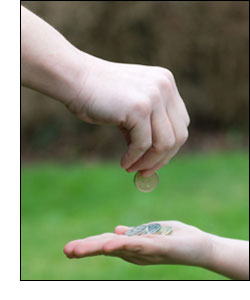 Have you ever thought to yourself when balancing your checkbook, "Why wasn't I taught this when I was younger?" It is common for adults to wish they were taught how to manage their money as children. Often we learned financial lessons the hard way – by making mistakes. However, mistakes do not necessarily have to be repeated. By teaching your children about money you can help them to become financially-responsible adults.
Have you ever thought to yourself when balancing your checkbook, "Why wasn't I taught this when I was younger?" It is common for adults to wish they were taught how to manage their money as children. Often we learned financial lessons the hard way – by making mistakes. However, mistakes do not necessarily have to be repeated. By teaching your children about money you can help them to become financially-responsible adults.
Teaching delayed gratification
Many of us have seen a child in a store yelling, "Mommy, buy me that toy, I want it now!" In fact, your own children may have done this. This provides a good opportunity to teach your children that money is earned, and if there is not enough money to afford an item it has to be saved for first. This is a valuable lesson to learn, because it is unlikely that when your children become adults they will have enough money to purchase everything they want. When people learn to save, instead of purchasing things right away when they want them, they are less likely to depend on credit and acquire debt. You can further reinforce the importance of not making purchases when you do not have the money by using cash, instead of credit, when shopping with your kids.
Using an allowance to teach budgeting and saving skills
A good way to start teaching your children how to budget and save is to give them a set allowance, instead of giving them money whenever they ask for it. It is usually best to give the allowance at fixed intervals, such as weekly or monthly. You can give your children enough money to cover their fixed expenses, such as school lunches and transportation, and a little extra to save. (If your children are older and working part-time it would not be unreasonable to not give any allowance.) Help them to create a budget and record their expenses so that they can stay on budget. You can also help them set a goal for their savings, such as buying a new bicycle. For younger children a piggy bank is a great savings tool. They will be able to pick it up and feel it getting heavier as they save! For older children consider opening up a savings or checking account. Your financial institution may offer special accounts for teens, or you can open a joint account. Not only will having the account give your children a place to put their savings, but you can teach them about the importance of checking your account balance before making withdrawals.
Teaching the effects of interest
As your children become more aware of the value of money you can begin to teach them about how interest works. This way they will know that they can earn money by saving and, conversely, lose money by borrowing. If your children put their money in piggy banks consider paying them interest on the money they have in there. Let them know they are earning this interest because they have saved money. If your children have checking or savings accounts on their statements you can point out to them the interest they have earned. On the other hand, if your children want to borrow money you can charge them interest. (Consider not lending them money too often, though, or it may be hard for them to learn the importance of budgeting.) This is what they will have to do as adults if they take out a loan or carry a balance on their credit cards.
Delaying gratification and saving is not always easy. Your children may be resistant at first. However, when they are adults, balancing their checkbooks, they will probably be glad their parents taught them about money when they were younger.



